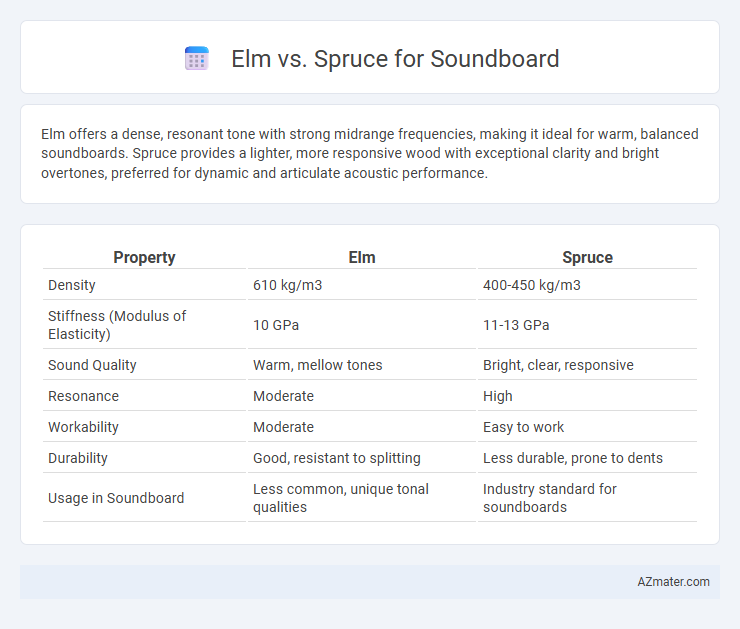Elm offers a dense, resonant tone with strong midrange frequencies, making it ideal for warm, balanced soundboards. Spruce provides a lighter, more responsive wood with exceptional clarity and bright overtones, preferred for dynamic and articulate acoustic performance.
Table of Comparison
| Property | Elm | Spruce |
|---|---|---|
| Density | 610 kg/m3 | 400-450 kg/m3 |
| Stiffness (Modulus of Elasticity) | 10 GPa | 11-13 GPa |
| Sound Quality | Warm, mellow tones | Bright, clear, responsive |
| Resonance | Moderate | High |
| Workability | Moderate | Easy to work |
| Durability | Good, resistant to splitting | Less durable, prone to dents |
| Usage in Soundboard | Less common, unique tonal qualities | Industry standard for soundboards |
Introduction: The Importance of Soundboard Wood Choice
Soundboard wood choice critically influences the tonal quality and resonance in acoustic instruments, with Elm and Spruce being prominent options. Spruce is prized for its lightweight properties and superior stiffness-to-weight ratio, enhancing sound projection and clarity in guitars and pianos. Elm offers distinctive damping characteristics and durability, resulting in warmer tones and increased resistance to environmental changes, making it a valuable alternative in soundboard construction.
Elm Wood Overview: Characteristics and Acoustic Qualities
Elm wood features a dense, interlocking grain structure that offers exceptional strength and resistance to splitting, making it a durable choice for soundboards. Its moderate density and open-grain texture provide a balanced resonance with a warm, rich tonal quality that enhances midrange frequencies. Compared to spruce, elm delivers a unique acoustic profile characterized by a slightly softer attack and fuller sustain, ideal for producing a distinctive, mellow sound in musical instruments.
Spruce Wood Overview: Characteristics and Acoustic Qualities
Spruce wood is highly valued for soundboards due to its lightweight structure and exceptional strength-to-weight ratio, which enhances resonance and tonal clarity. Its straight grain and fine, uniform texture contribute to consistent vibration transmission, producing bright, responsive, and well-balanced sound. Spruce is commonly preferred over elm for instruments where dynamic range and projection are critical.
Acoustic Performance: Elm vs Spruce Soundboards
Spruce soundboards excel in acoustic performance due to their high stiffness-to-weight ratio, producing a bright, clear, and resonant tone favored in guitars and violins. Elm, while less common in soundboards, offers a denser, heavier grain that results in a warmer, more muted sound with less resonance than spruce. Spruce's superior elasticity and responsiveness make it the preferred choice for soundboards seeking dynamic range and projection.
Durability and Longevity: Comparing Elm and Spruce
Elm exhibits exceptional durability due to its interlocking grain structure, making it highly resistant to splitting and wear, ideal for soundboards subjected to prolonged use. Spruce, prized for its lightweight and resonant qualities, offers excellent longevity by maintaining structural integrity while providing superior acoustic properties. Selecting between elm and spruce for soundboards involves balancing elm's robustness against spruce's proven performance in sustaining sound quality over time.
Workability and Crafting Differences
Elm offers superior workability for soundboard crafting due to its open grain and moderate hardness, allowing easier shaping and fine detailing compared to spruce. Spruce is prized for its light weight and consistent grain, which enhances acoustic resonance but requires more careful handling and precise tools to avoid splintering. The contrasting textures between elm and spruce influence the crafting process, with elm providing a sturdier, more forgiving material and spruce demanding skilled craftsmanship for optimal soundboard performance.
Cost and Availability of Elm vs Spruce
Elm wood is generally more affordable and widely available compared to spruce, making it a cost-effective choice for soundboard construction in acoustic instruments. Spruce, especially Sitka and Adirondack varieties, is prized for its superior strength-to-weight ratio and tonal qualities but often comes at a higher price due to limited supply and higher demand. Availability of spruce can fluctuate regionally, while elm, being more common and less sought after, tends to maintain steady market presence and pricing.
Aesthetic Considerations: Grain and Appearance
Elm offers a distinctive interlocking grain pattern with rich, warm tones that create a visually dynamic soundboard, enhancing both vintage and rustic acoustic aesthetics. Spruce features a fine, straight grain with a consistent pale color, providing a clean and refined appearance preferred in modern and classical instrument designs. The unique grain structure of Elm contributes to a bold visual texture, while Spruce's uniformity supports a sleek and polished finish.
Popular Use Cases in Musical Instruments
Elm wood, known for its flexible yet strong grain, is popular in electric guitar bodies and drum shells, offering a warm tone with strong midrange frequencies preferred by blues and rock musicians. Spruce, especially Sitka spruce, is widely used in acoustic guitar tops and violin soundboards due to its excellent stiffness-to-weight ratio, delivering bright, resonant sound with clear articulation favored by classical and folk instrumentalists. Both woods optimize soundboard performance by balancing resonance and durability but cater to distinct tonal qualities and musical styles.
Conclusion: Choosing the Right Wood for Your Soundboard
Elm offers a rich, warm tone with excellent midrange clarity, making it ideal for soundboards where resonance and natural warmth are prioritized. Spruce provides superior stiffness-to-weight ratio, delivering bright, clear, and responsive sound favored in instruments requiring precise articulation and dynamic range. Selecting the right wood depends on your tonal preferences and structural needs, with elm suited for a mellow, full-bodied voice and spruce excelling in brightness and projection.

Infographic: Elm vs Spruce for Soundboard
 azmater.com
azmater.com